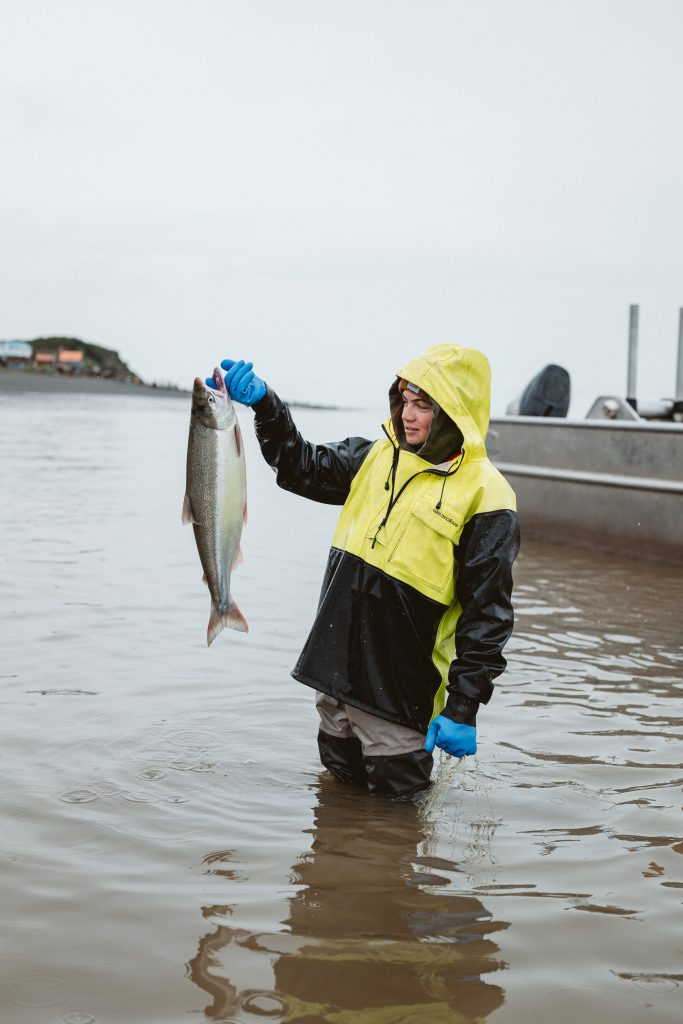In a desolate corner of the world, the salt water in a bay appears to stand still. Placid, it reflects the pink and yellow of the rising sun. Scattered over the horizon are distant freckles of fishing boats, concentrated in areas where large quantities of fish teem. A Willow Ptarmigan signals the oncoming light with a melodious whistle. The waves slosh back and forth in a rhythmic hum.
The consistent push and pull of the tide is a constant companion in the villages that surround this bay — Bristol Bay, Alaska, and it has been for centuries. In fact, today, from the months of May to August when the sockeye salmon run infiltrates the area, the tide is still the only clock that fishermen live by. Out to sea or on land, people can be found working at all hours as dictated by the water’s depleting and rising levels. During these few months, the village floods with people—workers, fishermen, family, mechanics— similar to the surge of salmon produced with an incoming tide. At the end of the summer, the land returns to stark desolation, allowing the wild, harmonious notes of the tundra to be heard. Some would call it peaceful.
The tranquill image of this bay is an illusion, however. For on the water, miles out to sea, men are yelling profanities at each other. I say men because, until the 1950s, it was unheard of for women to work on commercial fishing vessels in Bristol Bay, Alaska. Although it is much more common today, the industry is still male dominated; women make up roughly 30 percent or less of active permit holders.
I have just finished my 11th season of commercial fishing in Bristol Bay. Specifically, in a little village within this bay called South Naknek. For context, South Naknek has a total population of 67 people who live there year round, averaging about one person per square mile, according to the 2020 Alaska Peninsula Corporation census. There is no grocery store in this town, small amounts of electricity, and very few bathrooms that have indoor plumbing. Most of the cabins that are scattered on the bluff or across the tundra have no insulation and are heated by a wood stove. The nearest medical clinic is a long drive (or short flight in a bush plane) across the frozen river.

My dad started fishing in South Naknek out of highschool; he fell in love with the lifestyle and made it a family endeavor once he had kids. So, for my entire life, I have trekked up north every summer to live in a plywood, tin roofed cabin on a bluff with my family, chase away bears, swat at mosquitos and fish. My dad, my brother and I (plus some other guys enlisted to work) fish for the sockeye salmon run on set net sites near our cabin. It’s all very “Alaska the Last Frontier” of us. I started working when I was 10, and am now a permit holder myself. My hands are calloused and swollen, looking more like they belong to a blue collar worker than a 21 year old girl.
The work is tough and the sleep minimal. There are probably about four hours in the period of 24 that I am not in waders, working knee deep in salmon. And for those precious moments, I hang my rank smelling gloves above the wood burning stove in the cabin to dry, briefly stretch my pruney fingers in front of the flames, grab a quick bite to eat, and fall into bed.
The wake up call always comes too soon. Within 10 minutes of opening my eyes, I need to pull on my still damp gloves over aching fingers, slip into my scale covered waders, and head back out to sea.After a few weeks of this routine, fatigue begins to take its toll. For a fast paced, fever dream of five weeks, my life revolves around this fishery. Afterwards, I return back to my normal life with modern conveniences. The 67 permanent residents of South Naknek, on the other hand, are left to survive the harsh winters.
I am just a visitor, a singular person who is a part of the larger picture that makes up the South Naknek fishery. The methods of survival and the ability to live off of the land is not something that I can even begin to take credit for. The women and men who have poured into this fishery for centuries, who survive in the stark tundra year round, working to feed their families over the winter —they are the ones who need to be remembered. Their voices hold power, they show the resilient nature of humankind and the ability to survive against all odds, yet they are tucked away somewhere in a remote village on the edge of Alaska.
Written By: Sofie Fransen
